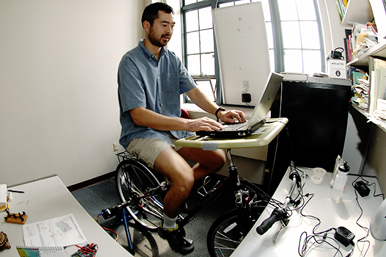Green Energy Powers Faculty Office
CAS prof builds a carbon-neutral workspace

If BU made professors pay every time they flipped a light switch or powered up a computer in their offices, Nathan Phillips wouldn’t pay a dime. Every appliance in his zero-carbon office runs on renewable energy, rather than energy that generates carbon dioxide — the leading cause of global warming.
The College of Arts and Sciences associate professor of geography and environment has a solar panel, as well as a stationary bicycle, hooked up to a small generator that operates, he says, “off the grid.” Phillips does not use his office’s overhead fluorescent lights, radiator, or air conditioning, and his laptop computer, telephone, and two small desk lamps are fueled by a combination of solar and human power.
Every day, Phillips hops on his bike and pedals to rev up his laptop, which sits on a tray that replaces the bike’s handlebars. “I burn calories instead of carbon,” he says. “Generally, I try to bike about an hour a day, although if it’s sunny, I can operate primarily from the solar panel.”
The energy generated by Phillips’ pedaling — approximately 100 to 150 watts of power — is stored in a 12-volt battery. “It’s completely proportional,” he says. “If I pedal faster, more energy goes in. When the battery is full, there’s more resistance, so it’s like pedaling uphill.”
On cloudy days, Phillips may have to get back on the bike and pedal, although he can operate at a deficit for approximately 24 hours, he says, before his laptop completely depletes the battery. “The setup is kind of like having a bank account,” he says. “You have to budget for unforeseen expenses.”
Phillips says his “green office” was inspired by his own research needs. “When I’m in remote field locations, like the forests of Oregon,” he explains, “I use solar panels to power tiny tools that measure how water flows through trees. I thought it would be interesting to see how well a solar panel would work in my own office, and that led to the experiment with the bike.”
He estimates that he saves 2.4 kilowatt-hours of electricity daily, which averages to an unimpressive-sounding 26 cents a day. But, he says, if more offices, classrooms, or labs implemented similar systems, the impact could be vast.
“This is only a small step toward sustainability,” he says. “But at least it’s a step.”
Phillips points to the FitRec Center as the most obvious place to launch a large-scale on-campus promotion of the benefits of pedal-generated electricity. In fact, he and Eileen Sullivan, a School of Education clinical assistant professor, are currently talking with FitRec officials about ways that the facility could incorporate exercise machines that could produce their own electricity.
“The technology is all there,” Phillips says, “and certainly the manpower is there. Wouldn’t it be wonderful if all of the energy the students expend while working out was in turn used to power the facility?”
Ultimately, Phillips hopes that his office will inspire additional research into energy technologies, environmental sustainability, and carbon emissions issues. “I’d like to create an atmosphere where the academic dimension of this type of experiment is taught on a local, regional, and global scale,” he says.
Vicky Waltz can be reached at vwaltz@bu.edu.